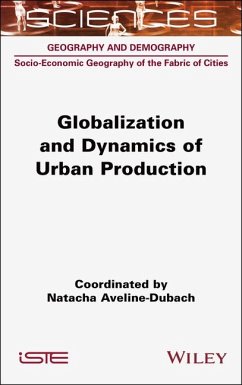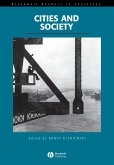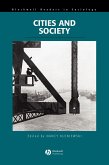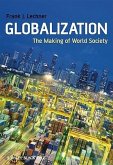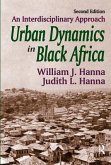Globalization and Dynamics of Urban Production
Herausgeber: Aveline-Dubach, Natacha
Globalization and Dynamics of Urban Production
Herausgeber: Aveline-Dubach, Natacha
- Gebundenes Buch
- Merkliste
- Auf die Merkliste
- Bewerten Bewerten
- Teilen
- Produkt teilen
- Produkterinnerung
- Produkterinnerung
Over the last 20 years, urbanization processes have undergone profound transformations under the growing influence of private actors, particularly in the financial sector. This has exposed the physical environment of various cities to global capital flows, which has generated an overall rise in real estate values on a global scale. This is often disconnected from the financial capacities of local actors - primarily households - which then increases the inequalities and vulnerabilities of societies regarding financial and environmental risks. This book offers the keys to understanding these new…mehr
Andere Kunden interessierten sich auch für
![Cities and Society Cities and Society]() Nancy KleniewskiCities and Society79,99 €
Nancy KleniewskiCities and Society79,99 €![Cities and Society Cities and Society]() Nancy KleniewskiCities and Society186,99 €
Nancy KleniewskiCities and Society186,99 €![Globalization Globalization]() Frank J LechnerGlobalization100,99 €
Frank J LechnerGlobalization100,99 €![Production Dynamics for Life Quality in the Incipient 21st Century Production Dynamics for Life Quality in the Incipient 21st Century]() Chau-kiu CheungProduction Dynamics for Life Quality in the Incipient 21st Century77,99 €
Chau-kiu CheungProduction Dynamics for Life Quality in the Incipient 21st Century77,99 €![Production Dynamics for Life Quality in the Incipient 21st Century Production Dynamics for Life Quality in the Incipient 21st Century]() Chau-kiu CheungProduction Dynamics for Life Quality in the Incipient 21st Century77,99 €
Chau-kiu CheungProduction Dynamics for Life Quality in the Incipient 21st Century77,99 €![Urban Dynamics in Black Africa Urban Dynamics in Black Africa]() William J HannaUrban Dynamics in Black Africa200,99 €
William J HannaUrban Dynamics in Black Africa200,99 €![The Production and Diffusion of Public Choice Political Economy The Production and Diffusion of Public Choice Political Economy]() Pitt Joseph / Djavad Salehi-Isfahani / Douglas Eckel (eds.)The Production and Diffusion of Public Choice Political Economy153,99 €
Pitt Joseph / Djavad Salehi-Isfahani / Douglas Eckel (eds.)The Production and Diffusion of Public Choice Political Economy153,99 €-
-
-
Over the last 20 years, urbanization processes have undergone profound transformations under the growing influence of private actors, particularly in the financial sector. This has exposed the physical environment of various cities to global capital flows, which has generated an overall rise in real estate values on a global scale. This is often disconnected from the financial capacities of local actors - primarily households - which then increases the inequalities and vulnerabilities of societies regarding financial and environmental risks. This book offers the keys to understanding these new dynamics of capital accumulation in the general built-up environment of cities by taking into account the diversity of their configurations, their intensity and their urban effects according to national contexts. Beyond the cases involving the major Western countries, the initial centers of the financial industry and the theorizations on the urban, this book addresses the particular contexts of real estate production in four major regions: Northeast Asia, Southeast Asia, the Middle East and West Africa.
Hinweis: Dieser Artikel kann nur an eine deutsche Lieferadresse ausgeliefert werden.
Hinweis: Dieser Artikel kann nur an eine deutsche Lieferadresse ausgeliefert werden.
Produktdetails
- Produktdetails
- Verlag: Wiley
- Seitenzahl: 272
- Erscheinungstermin: 11. Januar 2024
- Englisch
- Abmessung: 234mm x 156mm x 16mm
- Gewicht: 553g
- ISBN-13: 9781789451382
- ISBN-10: 1789451388
- Artikelnr.: 69528206
- Herstellerkennzeichnung
- Libri GmbH
- Europaallee 1
- 36244 Bad Hersfeld
- gpsr@libri.de
- Verlag: Wiley
- Seitenzahl: 272
- Erscheinungstermin: 11. Januar 2024
- Englisch
- Abmessung: 234mm x 156mm x 16mm
- Gewicht: 553g
- ISBN-13: 9781789451382
- ISBN-10: 1789451388
- Artikelnr.: 69528206
- Herstellerkennzeichnung
- Libri GmbH
- Europaallee 1
- 36244 Bad Hersfeld
- gpsr@libri.de
Natacha Aveline-Dubach is a research director at the CNRS in France, specializing in the political economy of urban production. She has also directed numerous projects in East Asia on the financialization of real estate, rail-city relations, city-health relations and aging.
Introduction xi
Natacha AVELINE-DUBACH
I.1 Market finance's stranglehold on the city xiv
I.2 Diversity of modes of capital accumulation in real estate xvii
I.3 What are the consequences for contemporary capitalisms? xix
I.4 References xx
Part 1 Sectoral Reconfigurations of Property Markets and Urban
(Re)Development 1
Chapter 1 The Financialized City and the Extraction of Urban Rent 3
Thierry THEURILLAT
1.1 Institutionalization of direct connections between the urban built
environment and financial markets 5
1.1.1 Securitization as a connector from the urban built environment to
market finance 6
1.1.2 The consolidation of the driving role of the urban built environment
thanks to connections to global investment circuits 8
1.1.3 Space at the heart of the valorization and extraction of value by the
Global City 9
1.2 Territorialized chains of financialized urban production: a transcalary
and multiactor re-intermediation 11
1.2.1 Financialization through the extraction of urban rent by financial
landowners 12
1.2.2 Financialization through the extraction of urban rent via household
property 15
1.2.3 The financialization of urban development strategies through
municipal land 17
1.3 Conclusion 19
1.4 References 21
Chapter 2 Real Estate Developers: Coordinating Actors in the Production of
the City 27
Julie POLLARD
2.1 The real estate developer, a multi-faceted player 29
2.1.1 What is a real estate developer? 29
2.1.2 The diversity of real estate developer profiles 31
2.2 The changing role of real estate developers: between market and
politics 34
2.2.1 Is financialization (re)shaping real estate developers? 34
2.2.2 How (and why) do developers integrate "social" objectives? 36
2.2.3 Are environmental issues transforming the practices of real estate
developers? 39
2.3 References 41
Chapter 3 Housing, Ownership, Assets and Debt: Geographical Approaches 47
Renaud LE GOIX
3.1 Introduction: a renewed interest in housing finance and home ownership
47
3.2 Is residential real estate becoming a financialized asset? 49
3.2.1 Geographical approaches to the financialization of real estate 49
3.2.2 Property and inflationary mechanisms 50
3.2.3 Asset-based welfare 53
3.3 Geographical analysis of property market regimes 54
3.3.1 The value of property in space, renewal of a critical analysis 54
3.3.2 The limits of classical approaches to prices in the city 55
3.3.3 Market regimes 57
3.4 Property and socio-spatial segregation 60
3.4.1 The role of credit and intermediation in inequality and segregation
60
3.4.2 The new market mechanisms, a strengthening of the relationship
between property and inequality 62
3.4.3 Sharing ownership 63
3.5 Conclusion 65
3.6 References 65
Chapter 4 Logistics Urbanization, Between Real Estate Financialization and
the Rise of Logistics Urban Planning 73
Nicolas RAIMBAULT and Adeline HEITZ
4.1 Introduction 73
4.2 Logistics development in the outer-suburbs: a dynamic of sprawl and
financialization of logistics real estate 75
4.2.1 An increase in the number of warehouses to supply major cities 76
4.2.2 The logistics sprawl of metropolitan areas on a global scale 78
4.2.3 Financialized production of outer-suburban logistics zones 82
4.2.4 The challenges of regulating the diffuse urbanization of economic
activities 85
4.3 Logistics development in urban centers: urban logistics 85
4.3.1 The rise of logistics real estate in urban centers: urban logistics
facilities 86
4.3.2 Towards a logistics urban planning 89
4.3.3 The rise of a logistics real estate market in urban centers 92
4.4 Logistics spaces in the inner suburbs: the case of intermediate
logistics as a blind spot in logistics urban planning 93
4.4.1 Permanence and mutations of intermediate logistics activities in the
suburbs 94
4.4.2 Intermediate logistics, a blind spot in public policy 96
4.5 Conclusion 97
4.6 References 98
Chapter 5 The City
Jean DEBRIE
5.1 The shift in city-port relations and the reconfiguration of intra-urban
scales 105
5.2 The levels of the port metropolis 106
5.2.1 The terminalization movement 106
5.2.2 The docklandization movement 109
5.3 The city-port interfaces, support for major urban projects 111
5.3.1 Standardization versus differentiation (forms/functions) 111
5.4 Who governs the port metropolis? 117
5.5 Conclusion: "Creating the city with the port?" The agenda of the port
metropolis 118
5.6 References 120
Part 2 Regional Dynamics of Capital Accumulation in East Asian, Middle
Eastern and West African Real Estate Markets 125
Chapter 6 Land Value Capture and Its Large-Scale Application in Northeast
Asia 127
Natacha AVELINE-DUBACH
6.1 Introduction 127
6.2 Origins and contemporary forms of LVC 130
6.2.1 Circulation of LVC models between the West and the East 130
6.2.2 Contemporary approaches to LVC 133
6.3 LVC strategies in East Asia 137
6.3.1 Flexible and consensual LVC practice in Japan 137
6.3.2 An LVC regime based on land concessions in Hong Kong 142
6.3.3 Optimization of the LVC by local governments in China 145
6.4 Conclusion 149
6.5 References 151
Chapter 7 The Dual Regionalization of Real Estate Financialization in
Southeast Asia 155
Gabriel FAUVEAUD
7.1 Introduction 155
7.2 The oligopolistic preconditions for the organization of real estate
markets in Southeast Asia 156
7.3 A privatization of land tenure 159
7.4 Regionalization and internationalization of real estate development 161
7.5 Towards a rescaling of real estate production and urban governance 163
7.6 Financialization of the regional real estate market 166
7.7 China and the new geopolitics of real estate in Southeast Asia 169
7.8 Conclusion 172
7.9 References 173
Chapter 8 Real Estate in the Middle East: An Economy Shaped by Rents 177
Myriam ABABSA
8.1 Introduction 177
8.2 The financialization of economies and real estate in the Middle East
180
8.2.1 Arab metropolises as engines of economic development 181
8.2.2 Half of foreign investments are in real estate in the Middle East 182
8.2.3 Capital invested in real estate and Arab real estate investment trust
187
8.2.4 Households' indebtedness for mortgages in the Middle East 189
8.2.5 The legalization of informal settlements through the titling of "dead
capital" 191
8.3 Egypt and Jordan: the squandering of public land and the construction
of new cities 192
8.3.1 The new cities of Cairo 192
8.3.2 The Abdali project, Amman 195
8.3.3 Rental renewals and their current outcomes in Cairo and Amman 196
8.4 Saudi Arabia: tax innovation to finance housing 198
8.5 Lebanon and Syria: reconstruction policies as a means of consolidating
elites 200
8.5.1 Lebanon, land of investor exemptions and subsidies 200
8.5.2 Syria confiscates refugees' property and deploys a policy of
territorial revenge 204
8.6 Conclusion 208
8.7 References 209
Chapter 9 Building Cities in West Africa: Construction Boom and Capitalism
213
Armelle CHOPLIN
9.1 Construction boom and cement industry 216
9.2 City-making: actors and sectors 218
9.3 Concrete, towers and megaprojects 220
9.4 "Social" housing programs 224
9.5 Self-build and incremental urbanization 227
9.6 Conclusion 228
9.7 References 229
Conclusion 235
Olivier CREVOISIER and Natacha AVELINE-DUBACH
C.1 The emergence of the international dimension of real estate 236
C.2 Real estate, a highly sought-after asset 237
C.3 The diversity of capital accumulation dynamics in real estate 237
C.4 From sectorial and induced real estate to the integrated and driving
production of urban construction 239
C.5 The financialized urban construct as a concrete scene of the global
city 240
C.6 Social consequences and the need for rethinking public policies `240
C.7 References 241
List of Authors 243
Index 245
Natacha AVELINE-DUBACH
I.1 Market finance's stranglehold on the city xiv
I.2 Diversity of modes of capital accumulation in real estate xvii
I.3 What are the consequences for contemporary capitalisms? xix
I.4 References xx
Part 1 Sectoral Reconfigurations of Property Markets and Urban
(Re)Development 1
Chapter 1 The Financialized City and the Extraction of Urban Rent 3
Thierry THEURILLAT
1.1 Institutionalization of direct connections between the urban built
environment and financial markets 5
1.1.1 Securitization as a connector from the urban built environment to
market finance 6
1.1.2 The consolidation of the driving role of the urban built environment
thanks to connections to global investment circuits 8
1.1.3 Space at the heart of the valorization and extraction of value by the
Global City 9
1.2 Territorialized chains of financialized urban production: a transcalary
and multiactor re-intermediation 11
1.2.1 Financialization through the extraction of urban rent by financial
landowners 12
1.2.2 Financialization through the extraction of urban rent via household
property 15
1.2.3 The financialization of urban development strategies through
municipal land 17
1.3 Conclusion 19
1.4 References 21
Chapter 2 Real Estate Developers: Coordinating Actors in the Production of
the City 27
Julie POLLARD
2.1 The real estate developer, a multi-faceted player 29
2.1.1 What is a real estate developer? 29
2.1.2 The diversity of real estate developer profiles 31
2.2 The changing role of real estate developers: between market and
politics 34
2.2.1 Is financialization (re)shaping real estate developers? 34
2.2.2 How (and why) do developers integrate "social" objectives? 36
2.2.3 Are environmental issues transforming the practices of real estate
developers? 39
2.3 References 41
Chapter 3 Housing, Ownership, Assets and Debt: Geographical Approaches 47
Renaud LE GOIX
3.1 Introduction: a renewed interest in housing finance and home ownership
47
3.2 Is residential real estate becoming a financialized asset? 49
3.2.1 Geographical approaches to the financialization of real estate 49
3.2.2 Property and inflationary mechanisms 50
3.2.3 Asset-based welfare 53
3.3 Geographical analysis of property market regimes 54
3.3.1 The value of property in space, renewal of a critical analysis 54
3.3.2 The limits of classical approaches to prices in the city 55
3.3.3 Market regimes 57
3.4 Property and socio-spatial segregation 60
3.4.1 The role of credit and intermediation in inequality and segregation
60
3.4.2 The new market mechanisms, a strengthening of the relationship
between property and inequality 62
3.4.3 Sharing ownership 63
3.5 Conclusion 65
3.6 References 65
Chapter 4 Logistics Urbanization, Between Real Estate Financialization and
the Rise of Logistics Urban Planning 73
Nicolas RAIMBAULT and Adeline HEITZ
4.1 Introduction 73
4.2 Logistics development in the outer-suburbs: a dynamic of sprawl and
financialization of logistics real estate 75
4.2.1 An increase in the number of warehouses to supply major cities 76
4.2.2 The logistics sprawl of metropolitan areas on a global scale 78
4.2.3 Financialized production of outer-suburban logistics zones 82
4.2.4 The challenges of regulating the diffuse urbanization of economic
activities 85
4.3 Logistics development in urban centers: urban logistics 85
4.3.1 The rise of logistics real estate in urban centers: urban logistics
facilities 86
4.3.2 Towards a logistics urban planning 89
4.3.3 The rise of a logistics real estate market in urban centers 92
4.4 Logistics spaces in the inner suburbs: the case of intermediate
logistics as a blind spot in logistics urban planning 93
4.4.1 Permanence and mutations of intermediate logistics activities in the
suburbs 94
4.4.2 Intermediate logistics, a blind spot in public policy 96
4.5 Conclusion 97
4.6 References 98
Chapter 5 The City
Jean DEBRIE
5.1 The shift in city-port relations and the reconfiguration of intra-urban
scales 105
5.2 The levels of the port metropolis 106
5.2.1 The terminalization movement 106
5.2.2 The docklandization movement 109
5.3 The city-port interfaces, support for major urban projects 111
5.3.1 Standardization versus differentiation (forms/functions) 111
5.4 Who governs the port metropolis? 117
5.5 Conclusion: "Creating the city with the port?" The agenda of the port
metropolis 118
5.6 References 120
Part 2 Regional Dynamics of Capital Accumulation in East Asian, Middle
Eastern and West African Real Estate Markets 125
Chapter 6 Land Value Capture and Its Large-Scale Application in Northeast
Asia 127
Natacha AVELINE-DUBACH
6.1 Introduction 127
6.2 Origins and contemporary forms of LVC 130
6.2.1 Circulation of LVC models between the West and the East 130
6.2.2 Contemporary approaches to LVC 133
6.3 LVC strategies in East Asia 137
6.3.1 Flexible and consensual LVC practice in Japan 137
6.3.2 An LVC regime based on land concessions in Hong Kong 142
6.3.3 Optimization of the LVC by local governments in China 145
6.4 Conclusion 149
6.5 References 151
Chapter 7 The Dual Regionalization of Real Estate Financialization in
Southeast Asia 155
Gabriel FAUVEAUD
7.1 Introduction 155
7.2 The oligopolistic preconditions for the organization of real estate
markets in Southeast Asia 156
7.3 A privatization of land tenure 159
7.4 Regionalization and internationalization of real estate development 161
7.5 Towards a rescaling of real estate production and urban governance 163
7.6 Financialization of the regional real estate market 166
7.7 China and the new geopolitics of real estate in Southeast Asia 169
7.8 Conclusion 172
7.9 References 173
Chapter 8 Real Estate in the Middle East: An Economy Shaped by Rents 177
Myriam ABABSA
8.1 Introduction 177
8.2 The financialization of economies and real estate in the Middle East
180
8.2.1 Arab metropolises as engines of economic development 181
8.2.2 Half of foreign investments are in real estate in the Middle East 182
8.2.3 Capital invested in real estate and Arab real estate investment trust
187
8.2.4 Households' indebtedness for mortgages in the Middle East 189
8.2.5 The legalization of informal settlements through the titling of "dead
capital" 191
8.3 Egypt and Jordan: the squandering of public land and the construction
of new cities 192
8.3.1 The new cities of Cairo 192
8.3.2 The Abdali project, Amman 195
8.3.3 Rental renewals and their current outcomes in Cairo and Amman 196
8.4 Saudi Arabia: tax innovation to finance housing 198
8.5 Lebanon and Syria: reconstruction policies as a means of consolidating
elites 200
8.5.1 Lebanon, land of investor exemptions and subsidies 200
8.5.2 Syria confiscates refugees' property and deploys a policy of
territorial revenge 204
8.6 Conclusion 208
8.7 References 209
Chapter 9 Building Cities in West Africa: Construction Boom and Capitalism
213
Armelle CHOPLIN
9.1 Construction boom and cement industry 216
9.2 City-making: actors and sectors 218
9.3 Concrete, towers and megaprojects 220
9.4 "Social" housing programs 224
9.5 Self-build and incremental urbanization 227
9.6 Conclusion 228
9.7 References 229
Conclusion 235
Olivier CREVOISIER and Natacha AVELINE-DUBACH
C.1 The emergence of the international dimension of real estate 236
C.2 Real estate, a highly sought-after asset 237
C.3 The diversity of capital accumulation dynamics in real estate 237
C.4 From sectorial and induced real estate to the integrated and driving
production of urban construction 239
C.5 The financialized urban construct as a concrete scene of the global
city 240
C.6 Social consequences and the need for rethinking public policies `240
C.7 References 241
List of Authors 243
Index 245
Introduction xi
Natacha AVELINE-DUBACH
I.1 Market finance's stranglehold on the city xiv
I.2 Diversity of modes of capital accumulation in real estate xvii
I.3 What are the consequences for contemporary capitalisms? xix
I.4 References xx
Part 1 Sectoral Reconfigurations of Property Markets and Urban
(Re)Development 1
Chapter 1 The Financialized City and the Extraction of Urban Rent 3
Thierry THEURILLAT
1.1 Institutionalization of direct connections between the urban built
environment and financial markets 5
1.1.1 Securitization as a connector from the urban built environment to
market finance 6
1.1.2 The consolidation of the driving role of the urban built environment
thanks to connections to global investment circuits 8
1.1.3 Space at the heart of the valorization and extraction of value by the
Global City 9
1.2 Territorialized chains of financialized urban production: a transcalary
and multiactor re-intermediation 11
1.2.1 Financialization through the extraction of urban rent by financial
landowners 12
1.2.2 Financialization through the extraction of urban rent via household
property 15
1.2.3 The financialization of urban development strategies through
municipal land 17
1.3 Conclusion 19
1.4 References 21
Chapter 2 Real Estate Developers: Coordinating Actors in the Production of
the City 27
Julie POLLARD
2.1 The real estate developer, a multi-faceted player 29
2.1.1 What is a real estate developer? 29
2.1.2 The diversity of real estate developer profiles 31
2.2 The changing role of real estate developers: between market and
politics 34
2.2.1 Is financialization (re)shaping real estate developers? 34
2.2.2 How (and why) do developers integrate "social" objectives? 36
2.2.3 Are environmental issues transforming the practices of real estate
developers? 39
2.3 References 41
Chapter 3 Housing, Ownership, Assets and Debt: Geographical Approaches 47
Renaud LE GOIX
3.1 Introduction: a renewed interest in housing finance and home ownership
47
3.2 Is residential real estate becoming a financialized asset? 49
3.2.1 Geographical approaches to the financialization of real estate 49
3.2.2 Property and inflationary mechanisms 50
3.2.3 Asset-based welfare 53
3.3 Geographical analysis of property market regimes 54
3.3.1 The value of property in space, renewal of a critical analysis 54
3.3.2 The limits of classical approaches to prices in the city 55
3.3.3 Market regimes 57
3.4 Property and socio-spatial segregation 60
3.4.1 The role of credit and intermediation in inequality and segregation
60
3.4.2 The new market mechanisms, a strengthening of the relationship
between property and inequality 62
3.4.3 Sharing ownership 63
3.5 Conclusion 65
3.6 References 65
Chapter 4 Logistics Urbanization, Between Real Estate Financialization and
the Rise of Logistics Urban Planning 73
Nicolas RAIMBAULT and Adeline HEITZ
4.1 Introduction 73
4.2 Logistics development in the outer-suburbs: a dynamic of sprawl and
financialization of logistics real estate 75
4.2.1 An increase in the number of warehouses to supply major cities 76
4.2.2 The logistics sprawl of metropolitan areas on a global scale 78
4.2.3 Financialized production of outer-suburban logistics zones 82
4.2.4 The challenges of regulating the diffuse urbanization of economic
activities 85
4.3 Logistics development in urban centers: urban logistics 85
4.3.1 The rise of logistics real estate in urban centers: urban logistics
facilities 86
4.3.2 Towards a logistics urban planning 89
4.3.3 The rise of a logistics real estate market in urban centers 92
4.4 Logistics spaces in the inner suburbs: the case of intermediate
logistics as a blind spot in logistics urban planning 93
4.4.1 Permanence and mutations of intermediate logistics activities in the
suburbs 94
4.4.2 Intermediate logistics, a blind spot in public policy 96
4.5 Conclusion 97
4.6 References 98
Chapter 5 The City
Jean DEBRIE
5.1 The shift in city-port relations and the reconfiguration of intra-urban
scales 105
5.2 The levels of the port metropolis 106
5.2.1 The terminalization movement 106
5.2.2 The docklandization movement 109
5.3 The city-port interfaces, support for major urban projects 111
5.3.1 Standardization versus differentiation (forms/functions) 111
5.4 Who governs the port metropolis? 117
5.5 Conclusion: "Creating the city with the port?" The agenda of the port
metropolis 118
5.6 References 120
Part 2 Regional Dynamics of Capital Accumulation in East Asian, Middle
Eastern and West African Real Estate Markets 125
Chapter 6 Land Value Capture and Its Large-Scale Application in Northeast
Asia 127
Natacha AVELINE-DUBACH
6.1 Introduction 127
6.2 Origins and contemporary forms of LVC 130
6.2.1 Circulation of LVC models between the West and the East 130
6.2.2 Contemporary approaches to LVC 133
6.3 LVC strategies in East Asia 137
6.3.1 Flexible and consensual LVC practice in Japan 137
6.3.2 An LVC regime based on land concessions in Hong Kong 142
6.3.3 Optimization of the LVC by local governments in China 145
6.4 Conclusion 149
6.5 References 151
Chapter 7 The Dual Regionalization of Real Estate Financialization in
Southeast Asia 155
Gabriel FAUVEAUD
7.1 Introduction 155
7.2 The oligopolistic preconditions for the organization of real estate
markets in Southeast Asia 156
7.3 A privatization of land tenure 159
7.4 Regionalization and internationalization of real estate development 161
7.5 Towards a rescaling of real estate production and urban governance 163
7.6 Financialization of the regional real estate market 166
7.7 China and the new geopolitics of real estate in Southeast Asia 169
7.8 Conclusion 172
7.9 References 173
Chapter 8 Real Estate in the Middle East: An Economy Shaped by Rents 177
Myriam ABABSA
8.1 Introduction 177
8.2 The financialization of economies and real estate in the Middle East
180
8.2.1 Arab metropolises as engines of economic development 181
8.2.2 Half of foreign investments are in real estate in the Middle East 182
8.2.3 Capital invested in real estate and Arab real estate investment trust
187
8.2.4 Households' indebtedness for mortgages in the Middle East 189
8.2.5 The legalization of informal settlements through the titling of "dead
capital" 191
8.3 Egypt and Jordan: the squandering of public land and the construction
of new cities 192
8.3.1 The new cities of Cairo 192
8.3.2 The Abdali project, Amman 195
8.3.3 Rental renewals and their current outcomes in Cairo and Amman 196
8.4 Saudi Arabia: tax innovation to finance housing 198
8.5 Lebanon and Syria: reconstruction policies as a means of consolidating
elites 200
8.5.1 Lebanon, land of investor exemptions and subsidies 200
8.5.2 Syria confiscates refugees' property and deploys a policy of
territorial revenge 204
8.6 Conclusion 208
8.7 References 209
Chapter 9 Building Cities in West Africa: Construction Boom and Capitalism
213
Armelle CHOPLIN
9.1 Construction boom and cement industry 216
9.2 City-making: actors and sectors 218
9.3 Concrete, towers and megaprojects 220
9.4 "Social" housing programs 224
9.5 Self-build and incremental urbanization 227
9.6 Conclusion 228
9.7 References 229
Conclusion 235
Olivier CREVOISIER and Natacha AVELINE-DUBACH
C.1 The emergence of the international dimension of real estate 236
C.2 Real estate, a highly sought-after asset 237
C.3 The diversity of capital accumulation dynamics in real estate 237
C.4 From sectorial and induced real estate to the integrated and driving
production of urban construction 239
C.5 The financialized urban construct as a concrete scene of the global
city 240
C.6 Social consequences and the need for rethinking public policies `240
C.7 References 241
List of Authors 243
Index 245
Natacha AVELINE-DUBACH
I.1 Market finance's stranglehold on the city xiv
I.2 Diversity of modes of capital accumulation in real estate xvii
I.3 What are the consequences for contemporary capitalisms? xix
I.4 References xx
Part 1 Sectoral Reconfigurations of Property Markets and Urban
(Re)Development 1
Chapter 1 The Financialized City and the Extraction of Urban Rent 3
Thierry THEURILLAT
1.1 Institutionalization of direct connections between the urban built
environment and financial markets 5
1.1.1 Securitization as a connector from the urban built environment to
market finance 6
1.1.2 The consolidation of the driving role of the urban built environment
thanks to connections to global investment circuits 8
1.1.3 Space at the heart of the valorization and extraction of value by the
Global City 9
1.2 Territorialized chains of financialized urban production: a transcalary
and multiactor re-intermediation 11
1.2.1 Financialization through the extraction of urban rent by financial
landowners 12
1.2.2 Financialization through the extraction of urban rent via household
property 15
1.2.3 The financialization of urban development strategies through
municipal land 17
1.3 Conclusion 19
1.4 References 21
Chapter 2 Real Estate Developers: Coordinating Actors in the Production of
the City 27
Julie POLLARD
2.1 The real estate developer, a multi-faceted player 29
2.1.1 What is a real estate developer? 29
2.1.2 The diversity of real estate developer profiles 31
2.2 The changing role of real estate developers: between market and
politics 34
2.2.1 Is financialization (re)shaping real estate developers? 34
2.2.2 How (and why) do developers integrate "social" objectives? 36
2.2.3 Are environmental issues transforming the practices of real estate
developers? 39
2.3 References 41
Chapter 3 Housing, Ownership, Assets and Debt: Geographical Approaches 47
Renaud LE GOIX
3.1 Introduction: a renewed interest in housing finance and home ownership
47
3.2 Is residential real estate becoming a financialized asset? 49
3.2.1 Geographical approaches to the financialization of real estate 49
3.2.2 Property and inflationary mechanisms 50
3.2.3 Asset-based welfare 53
3.3 Geographical analysis of property market regimes 54
3.3.1 The value of property in space, renewal of a critical analysis 54
3.3.2 The limits of classical approaches to prices in the city 55
3.3.3 Market regimes 57
3.4 Property and socio-spatial segregation 60
3.4.1 The role of credit and intermediation in inequality and segregation
60
3.4.2 The new market mechanisms, a strengthening of the relationship
between property and inequality 62
3.4.3 Sharing ownership 63
3.5 Conclusion 65
3.6 References 65
Chapter 4 Logistics Urbanization, Between Real Estate Financialization and
the Rise of Logistics Urban Planning 73
Nicolas RAIMBAULT and Adeline HEITZ
4.1 Introduction 73
4.2 Logistics development in the outer-suburbs: a dynamic of sprawl and
financialization of logistics real estate 75
4.2.1 An increase in the number of warehouses to supply major cities 76
4.2.2 The logistics sprawl of metropolitan areas on a global scale 78
4.2.3 Financialized production of outer-suburban logistics zones 82
4.2.4 The challenges of regulating the diffuse urbanization of economic
activities 85
4.3 Logistics development in urban centers: urban logistics 85
4.3.1 The rise of logistics real estate in urban centers: urban logistics
facilities 86
4.3.2 Towards a logistics urban planning 89
4.3.3 The rise of a logistics real estate market in urban centers 92
4.4 Logistics spaces in the inner suburbs: the case of intermediate
logistics as a blind spot in logistics urban planning 93
4.4.1 Permanence and mutations of intermediate logistics activities in the
suburbs 94
4.4.2 Intermediate logistics, a blind spot in public policy 96
4.5 Conclusion 97
4.6 References 98
Chapter 5 The City
Jean DEBRIE
5.1 The shift in city-port relations and the reconfiguration of intra-urban
scales 105
5.2 The levels of the port metropolis 106
5.2.1 The terminalization movement 106
5.2.2 The docklandization movement 109
5.3 The city-port interfaces, support for major urban projects 111
5.3.1 Standardization versus differentiation (forms/functions) 111
5.4 Who governs the port metropolis? 117
5.5 Conclusion: "Creating the city with the port?" The agenda of the port
metropolis 118
5.6 References 120
Part 2 Regional Dynamics of Capital Accumulation in East Asian, Middle
Eastern and West African Real Estate Markets 125
Chapter 6 Land Value Capture and Its Large-Scale Application in Northeast
Asia 127
Natacha AVELINE-DUBACH
6.1 Introduction 127
6.2 Origins and contemporary forms of LVC 130
6.2.1 Circulation of LVC models between the West and the East 130
6.2.2 Contemporary approaches to LVC 133
6.3 LVC strategies in East Asia 137
6.3.1 Flexible and consensual LVC practice in Japan 137
6.3.2 An LVC regime based on land concessions in Hong Kong 142
6.3.3 Optimization of the LVC by local governments in China 145
6.4 Conclusion 149
6.5 References 151
Chapter 7 The Dual Regionalization of Real Estate Financialization in
Southeast Asia 155
Gabriel FAUVEAUD
7.1 Introduction 155
7.2 The oligopolistic preconditions for the organization of real estate
markets in Southeast Asia 156
7.3 A privatization of land tenure 159
7.4 Regionalization and internationalization of real estate development 161
7.5 Towards a rescaling of real estate production and urban governance 163
7.6 Financialization of the regional real estate market 166
7.7 China and the new geopolitics of real estate in Southeast Asia 169
7.8 Conclusion 172
7.9 References 173
Chapter 8 Real Estate in the Middle East: An Economy Shaped by Rents 177
Myriam ABABSA
8.1 Introduction 177
8.2 The financialization of economies and real estate in the Middle East
180
8.2.1 Arab metropolises as engines of economic development 181
8.2.2 Half of foreign investments are in real estate in the Middle East 182
8.2.3 Capital invested in real estate and Arab real estate investment trust
187
8.2.4 Households' indebtedness for mortgages in the Middle East 189
8.2.5 The legalization of informal settlements through the titling of "dead
capital" 191
8.3 Egypt and Jordan: the squandering of public land and the construction
of new cities 192
8.3.1 The new cities of Cairo 192
8.3.2 The Abdali project, Amman 195
8.3.3 Rental renewals and their current outcomes in Cairo and Amman 196
8.4 Saudi Arabia: tax innovation to finance housing 198
8.5 Lebanon and Syria: reconstruction policies as a means of consolidating
elites 200
8.5.1 Lebanon, land of investor exemptions and subsidies 200
8.5.2 Syria confiscates refugees' property and deploys a policy of
territorial revenge 204
8.6 Conclusion 208
8.7 References 209
Chapter 9 Building Cities in West Africa: Construction Boom and Capitalism
213
Armelle CHOPLIN
9.1 Construction boom and cement industry 216
9.2 City-making: actors and sectors 218
9.3 Concrete, towers and megaprojects 220
9.4 "Social" housing programs 224
9.5 Self-build and incremental urbanization 227
9.6 Conclusion 228
9.7 References 229
Conclusion 235
Olivier CREVOISIER and Natacha AVELINE-DUBACH
C.1 The emergence of the international dimension of real estate 236
C.2 Real estate, a highly sought-after asset 237
C.3 The diversity of capital accumulation dynamics in real estate 237
C.4 From sectorial and induced real estate to the integrated and driving
production of urban construction 239
C.5 The financialized urban construct as a concrete scene of the global
city 240
C.6 Social consequences and the need for rethinking public policies `240
C.7 References 241
List of Authors 243
Index 245

